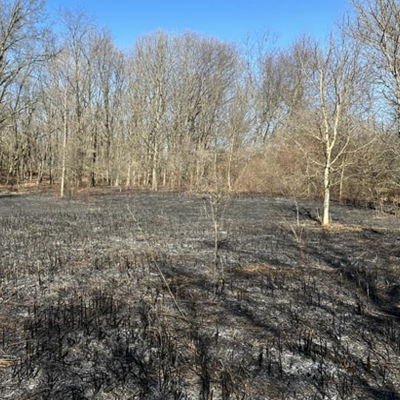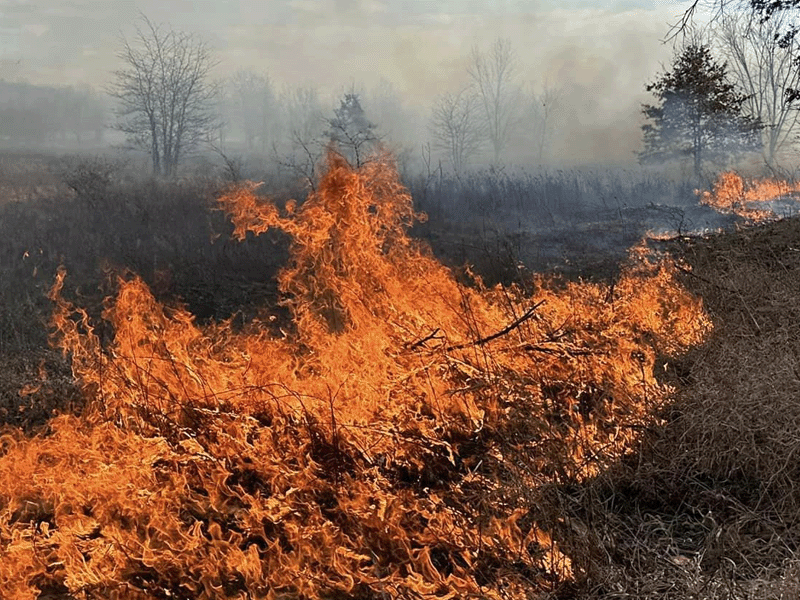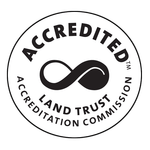News
Fire Season Updates
Notes from the Field by Bob Easter, Stewardship Director
NICHES Land Trust was able to complete successful prescribed burns over 460 acres in February and March!
Prescribed fire is one of the most important tools in NICHES stewardship toolbox. We work hard all year to maximize the positive impact of this practice. We plan our burn units based on the need of the preserves and the follow up opportunities provided by burning. Burn units are prepared in late summer/early fall and prescribed fires are implemented as conditions allow, with a focus on keeping fire activity within the fully dormant season as much as possible, mimicking the timing of anthropogenic fire as it was completed by native peoples of our region in the past. Dormant season burning protects fauna, minimizes damage to early emerging native plant species, top kills woody species, and removes thatch without releasing nitrogen. This provides opportunities for follow up herbicide treatment of invasive species in the spring, provides conditions for germination of native species from the seed bank, and creates nutrient conditions that are more favorable to native species than invaders.
Quality stewardship is an active process of learning and adapting to constantly improve how we approach our work. It is working tirelessly to get the best results possible with the least resources to safely and effectively manage our natural areas for the greatest benefit.

A record dry February had fuels very dry. We started 2024 prescribed fire with a ‘clean up’ burn on an old field area at Fall Creek Gorge which did not carry fire in December when the oak slopes were successfully burned because the non-native fescue grass in the area was still green. With the grass now cured and the surrounding area without fine fuels, we were easily able to burn this area with a small crew. This allowed us to get a feel for how things might burn in other units and finished our goals for the unit, providing an opportunity to return this spring and spray out the fescue, leaving the native sedges and grasses to regain dominance in this area.
Next, we looked toward a burn on a neighboring property to Weiler-Leopold with better fuels, and because of our results at Fall Creek Gorge we were confident we would have success. This unit was a 50 acre former CRP field that our neighbors needed help burning to get it re-enrolled in the program. We received help from the Purdue FNR Fire Ecology course to implement the burn successfully and help our neighbors prepare for over-seeding and get re-enrolled in the CRP program.
 With these two burns under our belt and dry conditions remaining, we looked to our biggest planned burn unit for the season: 165 acres at our new Farris Estate preserve. This property is a major project for NICHES. Earlier in the winter, partners from the U.S. Fish & Wildelife Service assisted with extensive forestry mulching of over 110 acres of of invasive shrub thickets. This formerly grazed remnant sand prairie/savanna has major issues that need resolved including the aforementioned invasive shrub thickets as well as a thick infestation of smooth brome that needs to be sprayed out this Spring to help release native species from the seed bank. Portions of the preserve retain high quality prairie vegetation, which will also greatly benefit from dormant season burning.
With these two burns under our belt and dry conditions remaining, we looked to our biggest planned burn unit for the season: 165 acres at our new Farris Estate preserve. This property is a major project for NICHES. Earlier in the winter, partners from the U.S. Fish & Wildelife Service assisted with extensive forestry mulching of over 110 acres of of invasive shrub thickets. This formerly grazed remnant sand prairie/savanna has major issues that need resolved including the aforementioned invasive shrub thickets as well as a thick infestation of smooth brome that needs to be sprayed out this Spring to help release native species from the seed bank. Portions of the preserve retain high quality prairie vegetation, which will also greatly benefit from dormant season burning.
NICHES Land Trust was able to pull off another 100+ acres of dormant prairie prescribed fire in February at Fisher Oak Savanna in Jasper County. Conditions allowed us to get a good fire through prairie fuels, despite it being overcast, relative humidities above 70%, and only two days since light precipitation. Knowing the general parameters for prescribed fire is not enough to maximize the best days for burning: We need to study weather patterns, know our fuel moisture levels, understand the differences between our preserves, such as surrounding landscape and local wind patterns. Today was a great day for this burn, although on paper the weather conditions would appear to be marginal.
Seasonal development in vegetation is being reported as 2-3 weeks ahead of a typical year as close as southern Illinois and Indiana. We have a few burn units prepared still, and we will make responsible decisions on whether or not to go ahead with burning them after upcoming precipitation or holding off until the next dormant season.
Thanks to our great stewardship staff, neighbor Nick Sizemore, Ken Jordan, a couple of prospective seasonal employees who joined as volunteers, partners from Wabash River Enhancement Corporation and ACRES Land Trust, and everyone who supports NICHES in every way for allowing us to get this important work completed.



